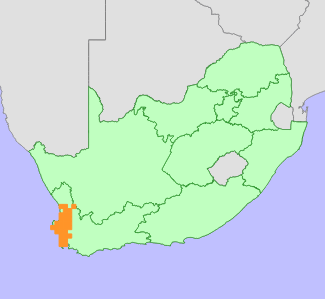|
Scientific Name | Aspalathus ternata (Thunb.) Druce |
Higher Classification | Dicotyledons |
Family | FABACEAE |
Synonyms | Aspalathus ferruginea H.P.Banks ex Benth., Aspalathus purpurascens E.Mey., Aspalathus purpurea Eckl. & Zeyh., Galega ternata Thunb., Paraspalathus purpurascens (E.Mey.) C.Presl |
National Status |
Status and Criteria | Near Threatened A2c |
Assessment Date | 2012/12/20 |
Assessor(s) | N.A. Helme, R. Koopman & L. von Staden |
Justification | A widespread (EOO 18 739 km²) and still common species, in spite of over 60% habitat loss. A population reduction of around 20% in the past 45 years (generation length 15 years) is estimated based on rates of habitat loss within lowland sand fynbos. |
Distribution |
Endemism | South African endemic |
Provincial distribution | Western Cape |
Range | Vredendal to the Cape Flats. |
Habitat and Ecology |
Major system | Terrestrial |
Major habitats | Namaqualand Strandveld, Cape Flats Dune Strandveld, Langebaan Dune Strandveld, Saldanha Flats Strandveld, Saldanha Granite Strandveld, Lambert's Bay Strandveld, Swartland Granite Renosterveld, Swartland Silcrete Renosterveld, Graafwater Sandstone Fynbos, Bokkeveld Sandstone Fynbos, Cape Flats Sand Fynbos, Atlantis Sand Fynbos, Hopefield Sand Fynbos, Leipoldtville Sand Fynbos, Swartland Alluvium Fynbos |
Description | Lowland sand fynbos. |
Threats |
| Threatened by habitat loss to urban expansion on the Cape Flats and along the West Coast, as well as habitat loss to expanding crop cultivation, particularly in the Sandveld, where there has been rapid, recent expansion of potato and rooibos tea cultivation. Many subpopulations are also threatened by competition from alien invasive plants, particularly on the sandy lowlands between Malmesbury and Durbanville. |
Population |
In spite of over 60% habitat loss, this species is still very common on the Cape coastal lowlands, with many recent records indicating that it still occurs at more than 50 locations. A recent survey of the Sandveld indicated that this species is still common in this area as well, and readily colonizes fallow lands (N.A. Helme and R. Koopman, pers. obs. 2012). A population reduction of around 20% is estimated based on rates of habitat loss over the past 45 years (three generations).
|
Population trend | Decreasing |
Assessment History |
Taxon assessed |
Status and Criteria |
Citation/Red List version | | Aspalathus ternata (Thunb.) Druce | VU A2abc; B1ab(i,ii,iii,iv,v) | 2012.1 | | Aspalathus ternata (Thunb.) Druce | VU A2abc; B1ab(i,ii,iii,iv,v) | Raimondo et al. (2009) | |
Bibliography |
Dahlgren, R. 1960. Revision of the genus Aspalathus. I. The species with flat leaflets. Opera Botanica 4:7-393.
Dahlgren, R. 1988. Crotalarieae (Aspalathus). In: O.A. Leistner (ed). Flora of southern Africa 16 Fabaceae, Part 3 Papilionoideae, Fascicle 6:1-430. National Botanical Institute, Pretoria.
Goldblatt, P. and Manning, J.C. 2000. Cape Plants: A conspectus of the Cape Flora of South Africa. Strelitzia 9. National Botanical Institute, Cape Town.
Raimondo, D., von Staden, L., Foden, W., Victor, J.E., Helme, N.A., Turner, R.C., Kamundi, D.A. and Manyama, P.A. 2009. Red List of South African Plants. Strelitzia 25. South African National Biodiversity Institute, Pretoria.
|
Citation |
| Helme, N.A., Koopman, R. & von Staden, L. 2012. Aspalathus ternata (Thunb.) Druce. National Assessment: Red List of South African Plants version 2024.1. Accessed on 2025/10/26 |
 Comment on this assessment
Comment on this assessment


